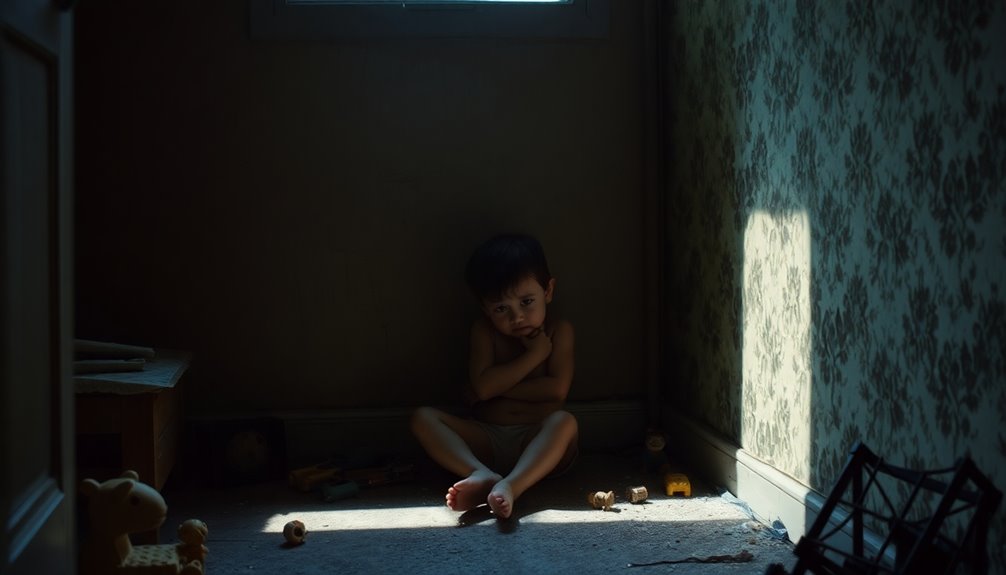Childhood psychological traumas deeply affect emotional and psychological development, often leaving lasting scars. I've seen how experiences like abuse, neglect, and loss can shape a person's life. These traumas create barriers in relationships and lead to trust issues and emotional dysregulation. Understanding their impact is vital for healing. Early intervention and supportive environments play a key role in building resilience. If you're curious about the types of trauma and their long-term effects, there's so much more to explore.
Key Takeaways
- Childhood psychological traumas, including abuse and neglect, significantly impact emotional development and relationships in adulthood.
- Early intervention is crucial for effective recovery, preventing trauma effects from becoming ingrained.
- Emotional resilience can be rebuilt through supportive environments and therapeutic approaches like play therapy and mindfulness.
- Various forms of loss and grief in childhood can disrupt emotional health, requiring understanding and appropriate support.
- Recognizing and addressing symptoms of childhood trauma in adults, like emotional dysregulation and trust issues, is essential for healing.
Understanding Childhood Psychological Traumas

How can we truly grasp the impact of childhood psychological traumas? It's crucial to recognize that these experiences shape not just our childhoods but our entire lives.
I've come to understand that trauma recovery isn't just about healing; it's about rebuilding our emotional resilience. Each of us carries our unique stories, and while some may seem less severe, the effects can be profound and lasting.
When a child faces trauma, it can disrupt their sense of safety and trust, creating barriers to connection and belonging.
I've learned that acknowledging this impact is the first step in healing. We need to create safe spaces where individuals can share their experiences without judgment.
Emotional resilience grows when we foster understanding and compassion, allowing us to move forward together.
Types of Childhood Traumas

Understanding the impact of childhood psychological traumas leads us to recognize the various types that can greatly affect a child's development. Each type of trauma leaves a unique imprint, shaping emotional and psychological health.
| Type of Trauma | Examples |
|---|---|
| Abuse | Physical abuse, sexual trauma |
| Neglect and Violence | Emotional neglect, domestic violence, bullying experiences |
| Environmental Stress | Community violence, natural disasters, medical trauma, refugee experiences |
Experiencing emotional neglect or parental separation can create feelings of abandonment. Similarly, exposure to community or domestic violence often results in deep-seated fears. Children affected by medical trauma may carry anxiety, while those dealing with bullying experiences might struggle with self-worth. Understanding these types helps us empathize with those who endure them, fostering a sense of belonging and care within our communities.
The Impact of Abuse on Emotional Development

Although many may not realize it, abuse during childhood profoundly influences emotional development.
I've seen how this trauma can create barriers to forming healthy relationships and expressing feelings. Children who experience abuse often struggle with trust, fearing vulnerability. This can lead to emotional numbness or, conversely, intense emotional responses, leaving them feeling isolated.
However, it's important to recognize that abuse recovery is possible. With the right support, individuals can build emotional resilience, learning to navigate their feelings and relationships more effectively.
Abuse recovery is achievable; with support, individuals can cultivate emotional resilience and healthier relationships.
Therapy and support groups can provide a safe space to process trauma and foster genuine connections with others.
Neglect and Its Long-lasting Effects

While abuse leaves deep scars on emotional development, neglect can be just as damaging, often in more subtle ways.
I've seen how emotional neglect creates attachment issues that hinder the ability to form healthy relationships. The absence of nurturing can lead to social isolation, making it hard to connect with others. This isolation often breeds self-esteem struggles, leaving many feeling unworthy of love or belonging.
As we navigate life, we develop coping mechanisms that may not serve us well. Trust difficulties can arise, and academic challenges become prevalent as our focus shifts from learning to just surviving.
Often, relationship patterns reflect these early wounds, repeating cycles of disconnection or fear. Recognizing the long-lasting effects of neglect is essential in healing, as it opens the door to understanding ourselves and fostering healthier connections in the future.
The Role of Loss and Grief in Childhood
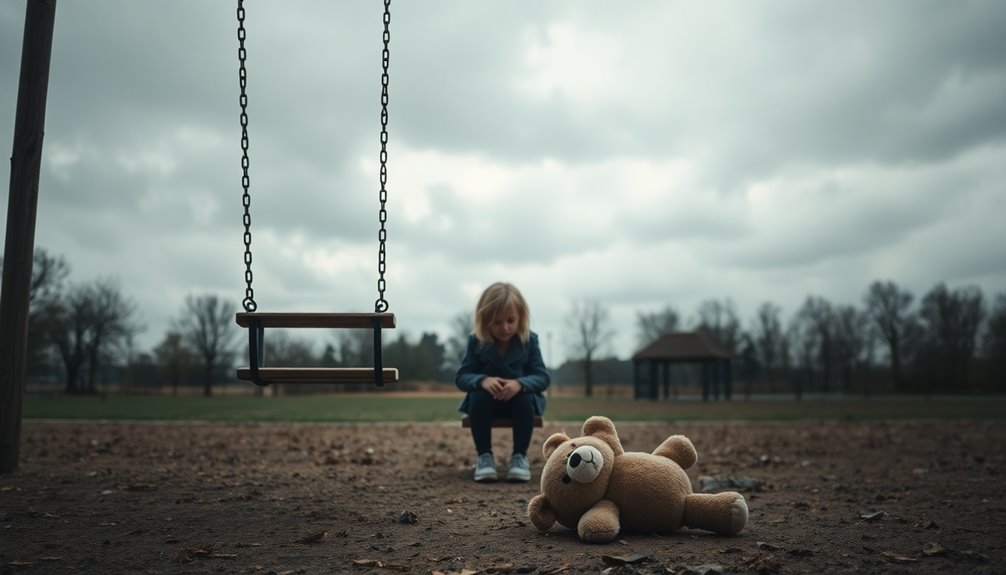
When I think about childhood, I realize that loss can come in many forms, whether it's the death of a loved one, the end of a friendship, or even a family relocation.
Each type of loss triggers a unique grieving process, and understanding the stages can help us support children as they navigate their feelings.
It's essential to recognize that the emotional effects of these experiences can last well into adulthood, shaping their outlook on relationships and coping mechanisms.
Types of Childhood Loss
Loss can feel like a heavy weight on a child's heart, manifesting in various forms that profoundly impact their development.
As I reflect on different types of childhood loss, I realize these loss experiences can range from the death of a loved one to the separation of parents or even the loss of a home. Each type carries its own emotional aftermath, shaping how a child views the world and their relationships.
The absence creates a void, leading to feelings of confusion, loneliness, and sometimes even guilt. It's crucial to recognize these losses, as understanding their nature can foster healing and connection.
Grieving Process Stages
Understanding the complexities of childhood loss naturally leads to exploring how children grieve. Grief expression in children often differs from adults, manifesting in unique stages. These stages can provide a framework for understanding their emotional coping.
| Stage | Description |
|---|---|
| Denial | Children may struggle to accept loss. |
| Anger | Feelings of frustration may arise. |
| Bargaining | They might wish for a different outcome. |
| Depression | Sadness can lead to withdrawal. |
| Acceptance | Eventually, they begin to heal. |
Recognizing these stages can help us support children through their journey. Each child's experience is distinct, and understanding their grief helps foster a sense of belonging during this challenging time.
Long-term Emotional Effects
As I reflect on the profound impact of childhood grief, it becomes clear that the emotional effects can linger long after the initial loss.
I've seen how unresolved grief can disrupt emotional regulation, leading to challenges in forming connections and managing feelings. The weight of loss often creates a barrier, making it hard to trust others or feel secure in relationships.
In my journey toward trauma recovery, I've learned that acknowledging these feelings is essential. Finding support and understanding from others who've faced similar losses fosters a sense of belonging.
It's important to remember that healing takes time, and with patience and compassion, we can navigate the complexities of grief and emerge stronger in our emotional well-being.
How Trauma Affects Brain Development
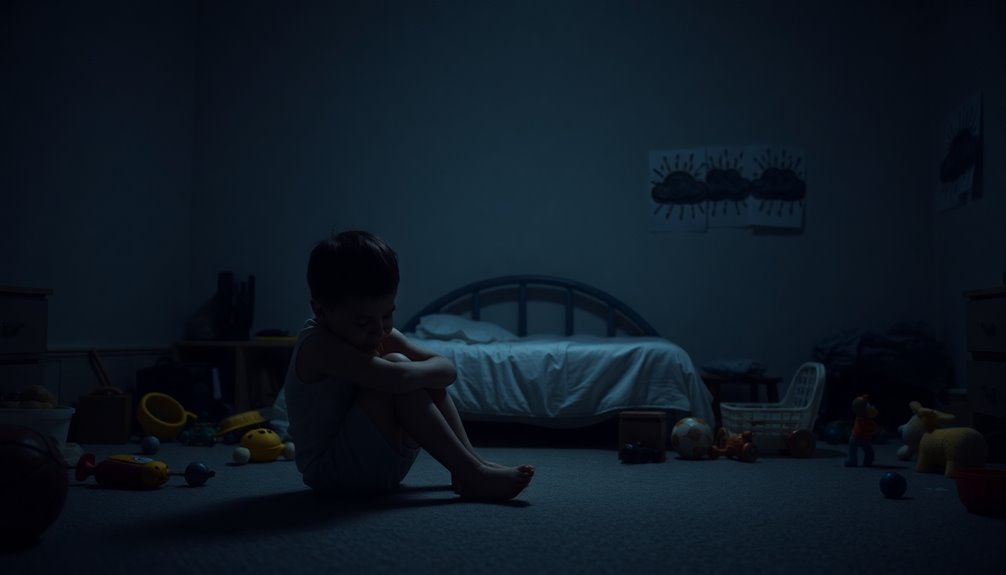
When I think about how trauma shapes a child's brain development, I can't help but feel concerned about the long-term effects it can have.
Trauma can disrupt neurodevelopment, leading to significant behavioral changes that might persist into adulthood.
Understanding this connection is essential for us to support those affected and foster healthier futures.
Impact on Neurodevelopment
While it might seem surprising, childhood psychological traumas can profoundly alter brain development, shaping not just immediate emotional responses but also long-term cognitive functions.
The neuroplasticity effects play an essential role here; our brains can adapt and reorganize themselves in response to trauma, but this doesn't always lead to positive outcomes. Instead, it can create pathways that reinforce anxiety, depression, or behavioral issues.
Understanding these changes is critical for those on the journey of trauma recovery. By recognizing how trauma impacts our brains, we can begin to foster resilience and promote healing.
You're not alone in this; many are working through similar experiences. Together, we can find ways to support one another in traversing this complex terrain of neurodevelopment.
Long-term Behavioral Changes
Though it might be hard to fathom, the long-term behavioral changes resulting from childhood trauma can be profound and far-reaching.
I've seen how trauma shapes attachment styles, often leading to insecure bonds in relationships. This can make forming connections feel intimidating, as fear of rejection looms large.
Many of us develop coping mechanisms to navigate these feelings, sometimes resorting to avoidance or aggression. While these strategies might offer temporary relief, they can hinder our ability to engage authentically with others.
Understanding these patterns is essential for healing. By recognizing how trauma influences our behaviors, we can begin to foster healthier relationships and create a sense of belonging that we all crave.
Healing is possible, and you're not alone on this journey.
Identifying Symptoms of Childhood Trauma in Adults
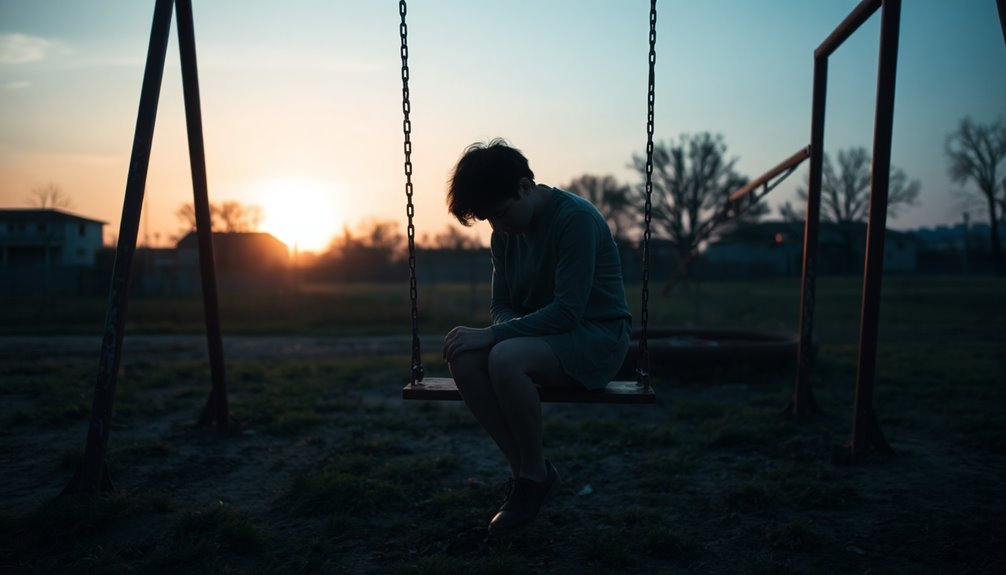
Although many adults may not immediately connect their struggles to childhood trauma, recognizing the symptoms can be an important step toward healing.
Recognizing childhood trauma symptoms is crucial for adults seeking healing and understanding of their struggles.
I've seen how these experiences can shape our lives, often leading to:
- Emotional dysregulation: Frequent mood swings and feelings of emotional numbness.
- Relationship difficulties: Trust issues and challenges in forming secure attachments.
- Avoidance behaviors: Social withdrawal or substance abuse as coping mechanisms.
These symptoms can manifest as anxiety disorders, identity confusion, or intrusive memories that haunt us.
It's vital to acknowledge these signs, as they often stem from unrecognized triggers. By understanding our attachment styles and self-esteem issues, we can begin to untangle the web of our past.
The Importance of Early Intervention
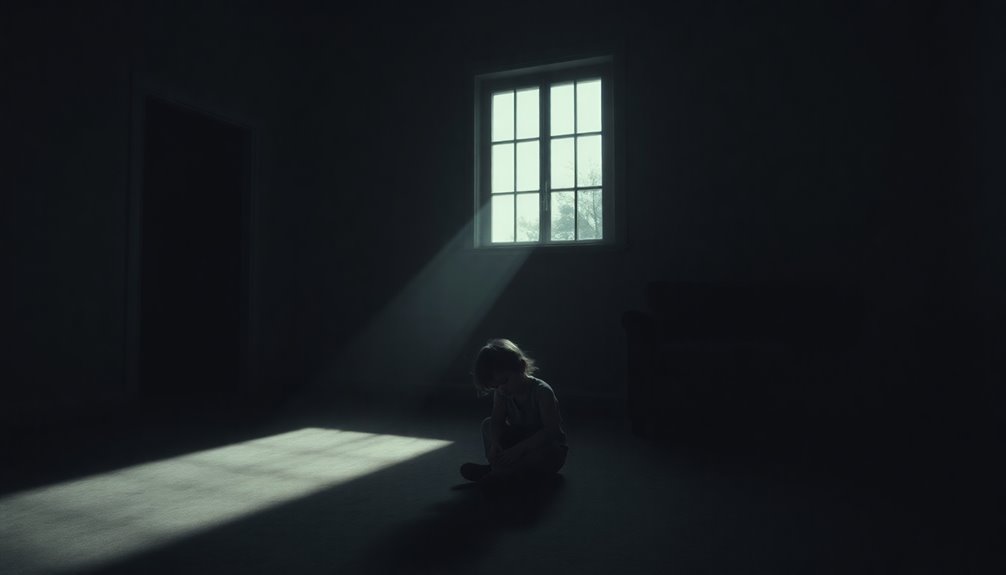
Understanding the significance of early intervention can profoundly impact a child's recovery from trauma. When we prioritize early detection, we open the door to healing before the effects of trauma become deeply ingrained.
I've seen how proactive measures can create a safe space for children to express their feelings and experiences. It's essential to recognize that trauma doesn't just disappear; it often lingers and manifests in various ways if left unaddressed.
Therapeutic Approaches to Healing Trauma

Recognizing the importance of early intervention naturally leads us to explore the various therapeutic approaches that can aid in healing trauma. Each method offers unique benefits, fostering a sense of belonging and understanding for those affected.
Exploring therapeutic approaches for trauma highlights the significance of early intervention and fosters healing through connection and understanding.
Here are a few effective approaches:
- Mindfulness techniques help individuals stay grounded and present, reducing anxiety.
- Play therapy provides a safe space for children to express feelings non-verbally, facilitating healing through creativity.
- Cognitive restructuring assists in changing negative thought patterns, enhancing self-compassion practices.
Incorporating trauma-informed care guarantees that all interactions prioritize safety and support, while expressive arts and narrative therapy allow individuals to share their stories in healing ways.
Group therapy can also create a sense of community, helping individuals understand their attachment styles.
Finally, psychoeducation equips individuals with knowledge about trauma, empowering them on their journey toward recovery. Together, these approaches can lead to profound healing and growth.
Building Resilience Through Support and Understanding
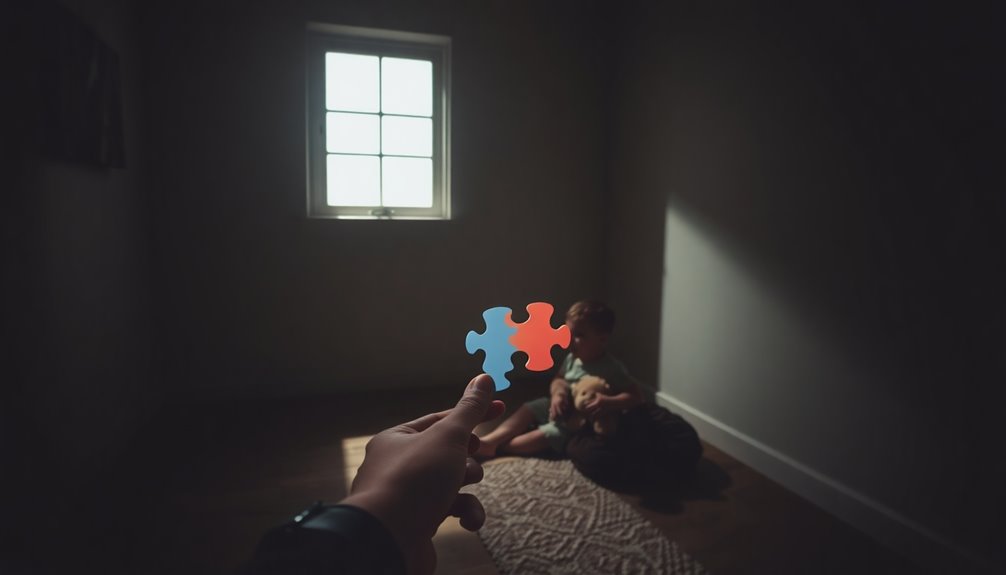
As we navigate the complexities of childhood trauma, it becomes clear that building resilience is essential for recovery. Support networks play a significant role in this journey.
When we foster understanding and empathy in our communities, we create safe spaces for healing. Resilience strategies, like positive reinforcement and emotional literacy, empower children to develop effective coping mechanisms.
Parental support is important; parents can model resilience and encourage open communication.
Additionally, community involvement strengthens peer relationships, allowing children to find solace in shared experiences.
Trauma-informed education helps us understand the unique needs of those affected, equipping educators with the tools to nurture resilience.
Frequently Asked Questions
Can Childhood Trauma Affect Academic Performance in Later Life?
I've often wondered how our past influences our present, especially regarding academic performance.
It's clear that academic resilience and emotional intelligence play essential roles in our success. When we face challenges, those with strong emotional intelligence can navigate difficulties better, fostering resilience.
Conversely, unresolved issues might hinder our ability to focus and thrive academically. Understanding this connection helps us cultivate a supportive environment where everyone can grow and succeed, despite their past experiences.
What Role Do Genetics Play in Childhood Trauma Responses?
Did you know that about 50% of our response to stress can be traced back to our genetic predisposition?
I find it fascinating how our genes influence trauma resilience. Some people seem naturally equipped to handle stress, while others struggle more.
This difference illustrates the complex interplay between genetics and our environment. By understanding this, we can foster empathy and support for those who face challenges in coping with life's difficulties.
How Can Parents Prevent Childhood Psychological Traumas?
When I think about how parents can prevent childhood psychological traumas, I believe it's essential to provide positive reinforcement and emotional support.
By celebrating their achievements, no matter how small, we help build their self-esteem.
I've found that being emotionally available, listening without judgment, and validating their feelings creates a safe space for kids.
This way, they can express themselves freely, fostering resilience and a strong sense of belonging in their lives.
Are Certain Children More Susceptible to Trauma Than Others?
I've often wondered if some kids are more vulnerable to trauma than others, and it turns out, they can be.
Socioeconomic factors play a significant role in shaping a child's emotional resilience. Kids from unstable environments may struggle more when faced with challenges.
However, building emotional resilience through supportive relationships can empower all children, helping them navigate their experiences.
It's crucial to understand these dynamics to foster a sense of belonging and security for every child.
Is There a Link Between Childhood Trauma and Physical Health Issues?
I've often wondered about the connection between childhood experiences and our physical health.
Research shows that a child's stress response can lead to long-term effects, impacting everything from immune function to chronic pain.
It's fascinating—and a bit alarming—that those early years can shape our adult health.
I believe understanding this link helps us foster empathy and support for one another, reminding us that our experiences are deeply intertwined with our overall well-being.
Conclusion
As I reflect on the shadows childhood traumas cast over lives, I see the delicate threads that weave our emotional landscapes. Each experience, whether of loss, neglect, or abuse, shapes us like a sculptor with clay. Yet, amidst the pain, there's hope—a light breaking through the clouds. By understanding and addressing these scars, we can nurture resilience and foster healing. Together, let's embrace the journey toward wholeness, where support and understanding pave the way for brighter tomorrows.

